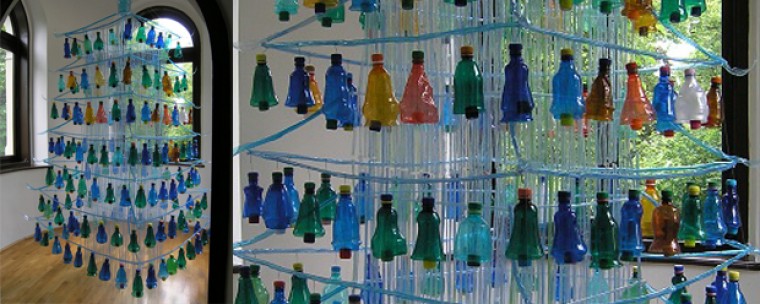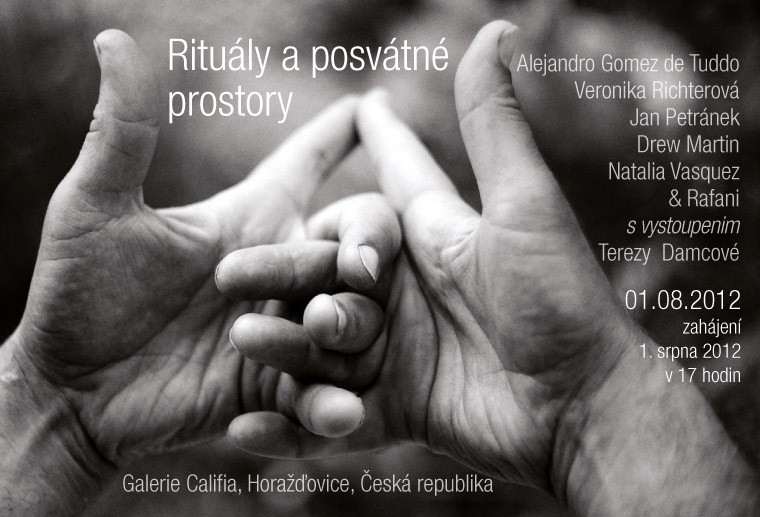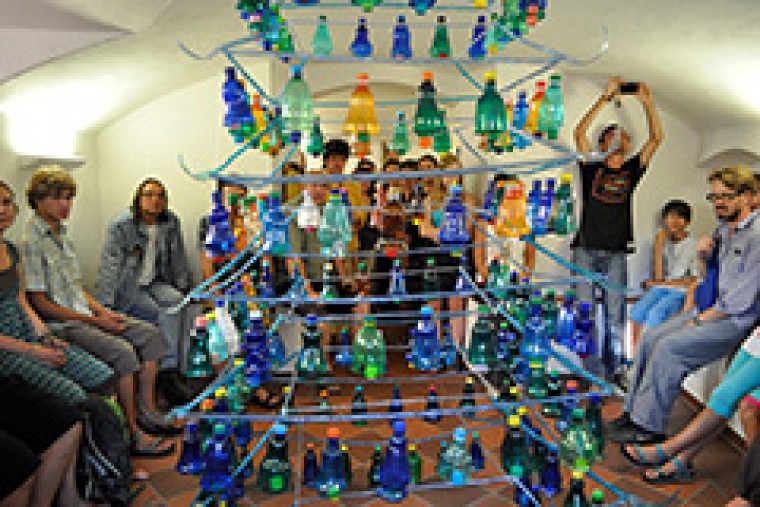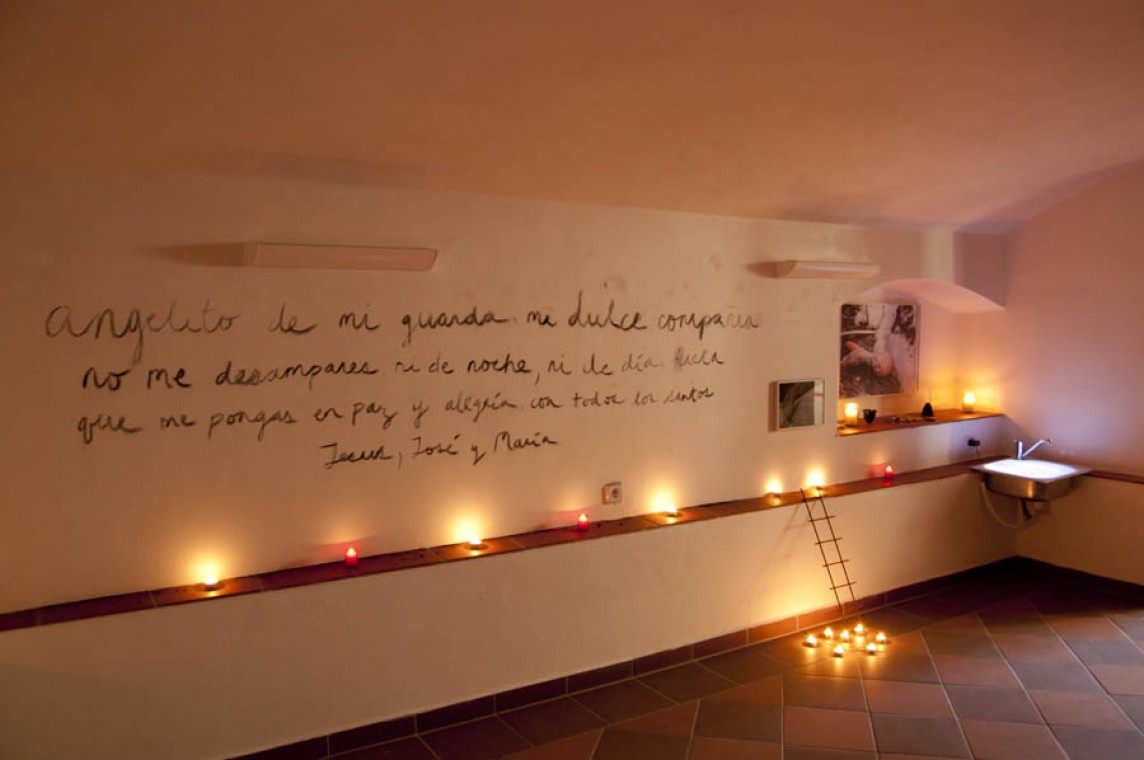Rituals & Sacred Spaces
Exhibition: August 1st – September 19th, 2012
Opening: August 1st at 6 pm
Opening words: Barbara Benish
Artists-in-Residence: Jan Petránek (CZ), Natalia Vasquez (Colombia/CZ), Alejandro Gomer de Tuddo (Mexico), Veronika Richterová (CZ), Drew Martin (USA)
Opening hours: Wed–Sun | 10 am – 4 pm (September 1st – October 31st | Fri–Sun | 10 am – 4 pm)
Rituals & Sacred Spaces
The exhibition Rituals & Sacred Spaces is inspired by the collection of sacred, votive clay figures and terracotta collected from several places in Western India, from the Gujarat state, near the south Rajasthan border. These ritual figures were collected in the last decade by Jan Petranek, a Czech traveler, photographer, and avid collector of traditional Indian folk art, whose village artists are also a dying breed. The figures made of clay are from various and in most cases, secret sites of religious offerings, where tourists are never led to.
In their raw simplicity, there is a purpose to their existence. They are used for a centuries-old Hindu ritual ceremony, and essentially sacred from their inception. As described by Petranek, “Potters are deeply religious people and each step of a process otherwise completely automated is a kind of ritual. The image of concentrated work is intensified by the ceremony of immolation of the wheel, the nearly sacred silence during the turning of the wheel and the prayers said to the God of Fire, insects and evil ghosts before the oven is lit. In a similar manner the selling of votive objects has its rituals: a lamp in honor of the sculpture is lit and a sacrifice is made to it and to everyone present. During this celebratory atmosphere the potter himself lifts the sculpture and places it on the head or shoulders of the buyer, who carefully carries it away. Even the slightest damage would thwart the whole ceremony; the sculpture would loose all its importance and would be unusable from a ritual point of view.”
Photographs by Petranek accompany the installation of selected votive figures to try and emphasize the profound sacred silence that is found in these sites.
The contemporary artists participating in this show explore religious ritual or and/or attempt to create their own sacred space in the gallery and its nearby vicinity.
Alejandro Gomez de Tuddo (born in Mexico, living in Paris) has a video titled “The Nino Fidencio and his Brothers in Light.” This film documentation shows the story from the 1920s, in the town of Espinazo, Nuevo Leon, in Northern Mexico, when José de Jesus Findencio Síntora Constantino, better known as “Nino Fidencio,” first earned a reputation as miraculous healer. Since 1938, the year in which he died, chosen people, known as Materias (Matter, in opposition to Spirit) or Cajitas (Little Boxes), began receiving the Nino’s spirit, thus perpetuating his charitable work as a healer. This film also shows other espíritus de luz (Spirits of Light) who have become manifest through other Materias or Cajitas, such as Margarita Catalán, Aurorita, the Santo Nino of Atocha and Pancho Villa, who come twice a year to the sacred sites in Espinazo: the Pirulito tree, the muddy waters of the Charquito, the Swing, the Cemetary, and, in solemn pilgrimage, climb up the Cuesta del dolor path, all the way to the Sepulcro (the Nino’s grave), in order to fulfill the healing rituals for the sick ones.”
Veronika Richterova (born in Czech Republic, living in Prague) creates PET art, works created from
Pethleham-Plastics, the disposable and yet irreplaceable containers of modern times. Due to the rise
of such plastics, the life of traditional pottery markets in India and other countries, for practical and
ritual use, are vanishing. And so, Veronika Richterova's contribution in this exhibition is an important
reminder of the lost world of original arts and crafts, not only in India, but around the world. Her
installations of PET art are also presented in a ritualistic presentation of her own.

Drew Martin (born in California and living in New Jersey) creates shrines of objects with discarded materials he finds around the sites where he builds them. While there is an element of Marcel Duchamp aesthetics, appreciating the design (and perhaps beauty) of a found object, the process is much more ritualistic in the way the objects are collected, cleaned and assembled. It is a method that is not only as ancient as man but is not unlike the instincts of nest building birds. The shrines Martin makes are typically public and collaborative; passersby are encouraged to take things from the shrine they might fancy, and leave behind their own keepsakes.
Natalia Vasquez (born in the Dominican Republic, was raised in Miami and currently lives in Prague) finally turns attention to the daily rituals and romps of children. Children play everywhere and anywhere, whenever they can. But there are also rules they should not forget, constantly issued by family and society. Meanwhile only up until recent years, playgrounds have tended to be uninviting, anti-social zones. In her series, "play here-don't get dirty." photos of these "play" zones around Prague and in various other cities around the world, are juxtaposed in sets of three. The other two images being of discarded dolls and toys, and then, anatomical remnants like hearts hanging from trees, to signify the disconnect between internal and external worlds. This natural confusion can occur, not only because of the many rules and rites to keep in mind, but also due to traumatic experiences and society's inability to create a safe space for healing and playing.
Finally, the art group Rafani is notorious for confronting society, and especially Czech habits, daily ritual and traditions in a way that is unsettling to some people. Selected short videos from their “nature” and “animal” series demarcate the distinction between the sacred and profane.
Tony Ozuna
August, 2012










